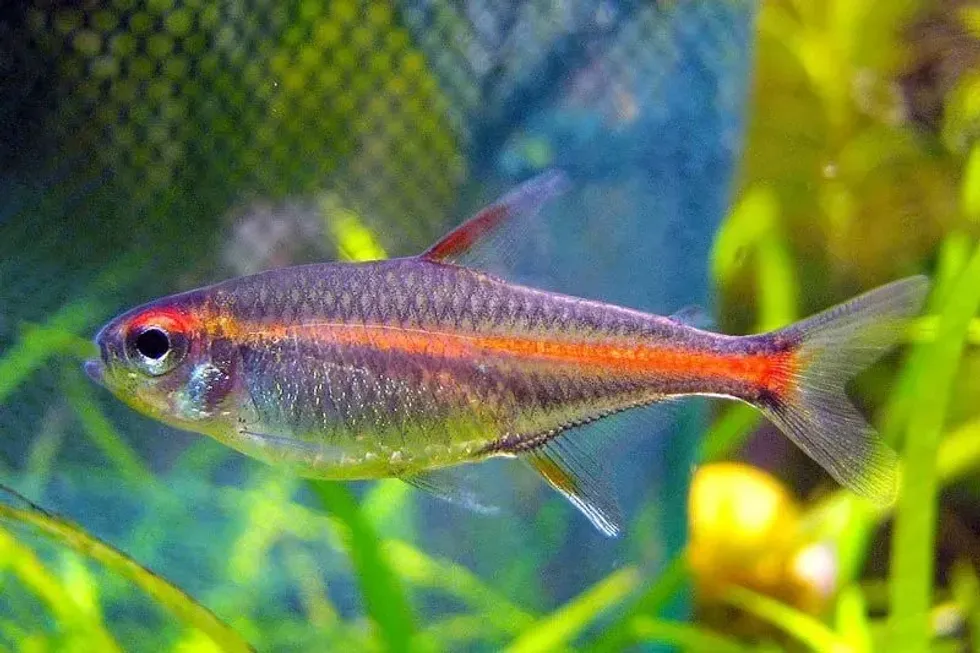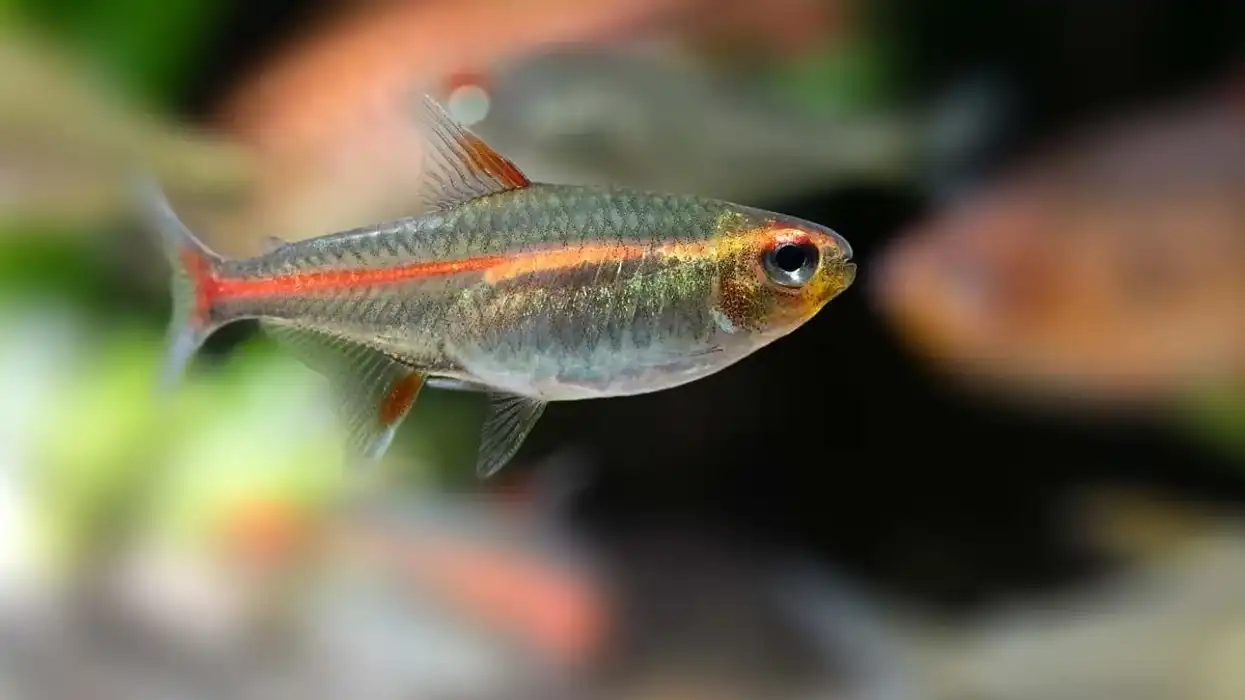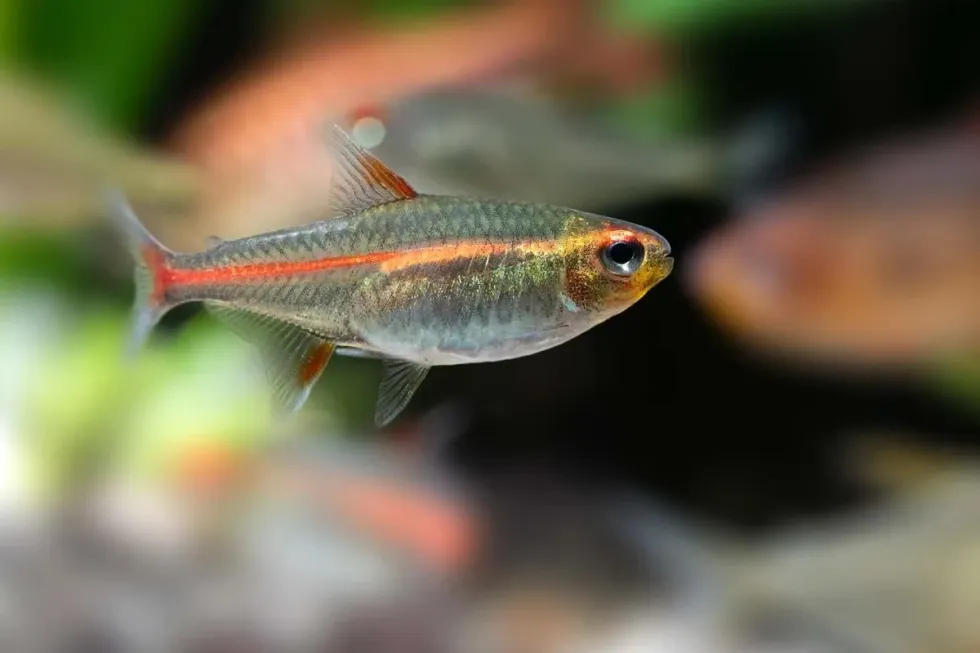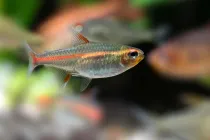Fun Glowlight Tetra Facts For Kids

Content
- What type of animal is a glowlight tetra?
- What class of animal does a glowlight tetra belong to?
- How many glowlight tetras are there in the world?
- Where does a glowlight tetra live?
- What is a glowlight tetra's habitat?
- Who do glowlight tetras live with?
- How long does a glowlight tetra live?
- How do they reproduce?
- What is their conservation status?
- What do glowlight tetras look like?
- How cute are they?
- How do they communicate?
- How big is a glowlight tetra?
- How fast can a glowlight tetra swim?
- How much does a glowlight tetra weigh?
- What are the male and female names of the species?
- What would you call a baby glowlight tetra?
- What do they eat?
- Are they aggressive?
- Would they make a good pet?
- Did you know...
- How to tell if a glowlight tetra is male or female
- How did the glowlight tetra get its name?
The glowlight tetra, known by the scientific name Hemigrammus erythrozonus, is one of the most preferred aquarium fish because of its peaceful nature and friendly behavior. The beautiful semi-transparent body of the fish is a treat to the eyes of many people.
They are a bit smaller than their relative species and show wonderful iridescent neon colors when the aquarium lighting conditions are proper.
As they are peaceful in nature they form a great option as tank mates and can coexist comfortably with other species. However, they school only with their own species.
It is better to avoid large fish species in the same aquarium of glowlight tetras as these small peaceful fish might fall prey to them. Since 1993, these fish have been a part of the aquarium trade and have been exported to countries of Europe and Asia.
It is almost impossible to find the tetras in the wild for the aquarium trade so most of them are bred in captivity for commercial purposes.
To keep the glowlight tetras healthy in captivity, it is better to keep them in an environment that imitates the glowlight tetra natural habitat. If you are interested to know more about this species then continue reading these fascinating facts.
For similar content check out these codfish and milkfish facts too.
Glowlight Tetra Interesting Facts
What type of animal is a glowlight tetra?
The glowlight tetra (Hemigrammus erythrozonus) is a freshwater fish. They are also one of the most beautiful fish of the tetra species.
What class of animal does a glowlight tetra belong to?
The glowlight tetras are ray-finned and bony fish of the order Characiformes that belong to the class Actinopterygii or the class of bony fishes.
How many glowlight tetras are there in the world?
The freshwater and peaceful glowlight tetras are present throughout the Essequibo River of Guyana, South America. These fish are also popular tank fish and are bred in captivity for commercial reasons.
The counterparts are exported to many countries all over the world. As a result, it becomes quite difficult for scientists to estimate the entire glowlight tetra population.
In a community tank, the fish is found in groups or schools of at least six along with the other glowlight tetra tank mates. These species do not face any fear of extinction as of now.
Where does a glowlight tetra live?
Various species of beautiful tetras are found to be distributed all over the extensive river systems of South America. One such new world tetra fish called the glowlight tetra (Hemigrammus erythrozonus) is found in plenty in the freshwater streams of the northern part of South America.
Glowlight tetras are believed to originate in the river basin of Essequibo river located in Guyana. The Essequibo river acts as a home to many different types of biotypes and these fish are one of them.
They are also available in the South American river systems of Mazaruni, and Potaro. Apart from that glowlight tetra fish form a great choice as an aquarium or community tank fish for many enthusiasts.
What is a glowlight tetra's habitat?
The natural habitat of glowlight tetra fish in the wild is essentially marked with thick and dense offshore vegetation and tall towering trees. They are found in the freshwater tributary streams of the main rivers where the water remains almost dark throughout the day due to heavy and thick tree covering.
The water in which they live looks stained and dark brown in color because of the humic acid produced from decaying leaves and the dark underground substrate.
The presence of humic acid in the natural water helps in improving the water conditions by removing the bacterias from it and makes the water slightly acidic. The turfy substrate is calcium-less and is mainly covered with rotten leaves which decreases the water hardness by a great level.
Likewise, there are certain water parameters and tank conditions that need to be checked before petting these freshwater fish.
Since they are dark water fish, keeping them in a dim-lit aquarium or tank with plenty of vegetation is recommended. However, there should be enough tank space should for free swimming of the fish.
There are also certain tetra tank water conditions that need to be followed for creating an ideal habitat for the fish in an aquarium for example maintaining the water temperature and adding tannins to produce soft water.
Glowlight tetra eggs cannot hatch in lighted places. Therefore the breeding tank should also have darker surroundings accordingly for the eggs to hatch.
Who do glowlight tetras live with?
Glowlight tetras are shoaling fish that remain happy and active when they are present in a homogeneous school. A glowlight tetra school mostly contains fish of its own type in the wild.
In a captive tank, they adapt well with other peaceful and small fish species like some other good-natured tetras, barbs, cory catfish, and guppies. Despite that, glowlight tetras need a minimum of six to eight fish of their own type as tank mates.
The glowlight tetras can fit in a small tank easily due to their small size. A 10 gal (37 l) tank can easily act as a home to six fish leaving enough space for their free swimming space.
How long does a glowlight tetra live?
The glowlight tetra lifespan is short and they can only stay alive for two to four years of age. To increase the longevity of these peaceful fish in captivity, they should be provided with a healthy environment, proper food and diet, and clean tanks.
How do they reproduce?
The fish reach sexual maturity when they become seven or eight months old. When interested to breed, the male fish will lock its fin with the female while swimming quickly around it.
Spawning in these species occurs when both the fish roll together. Spawning in glowlight tetras lasts for 1.5-2 hours.
The female glowlights release the eggs after spawning and the male assumes the responsibility of fertilizing them. The eggs are laid on the tank vegetation at first which gradually sink to the tank bottom.
The female glowlight tetra fish can lay around 120-150 eggs. Fertilization is rare in fish that breed for the first time.
They have a tendency to graze their own eggs and therefore should be immediately removed from the breeding tank once their spawning is over and the eggs are fertilized. Glowlight tetras care the least for their fry. The glowlights species' fry grows comparatively faster.
The young fish feed on flake food for the first two days and gradually start to feed on small animals. Glowlight tetra mating is a complex process compared to other tetras but they are bred commercially in large numbers.
They need separate breeding tanks and the temperature in this tank should vary between 79-82 F (26-28 C). Breeding takes place on the plants in the aquarium and in darkness.
The breeding pair should be fed well for successful fertilization. When the body of the female fish plumps up, they can be moved to the breeding tank where mating takes place the following morning or the day after spending some time together in the tank.
What is their conservation status?
The glowlight tetras do not have any particular status in the IUCN Red List as they are Not Listed as of yet. They occur in large numbers in the wild so they do not face any threat of extinction in the near future.
Glowlight Tetra Fun Facts
What do glowlight tetras look like?
The glowlight tetras are one of the most beautiful and extraordinary tetras to be present in the world. They look similar to their relative species, the cardinal or the neon tetras.
The most unique feature of the fish is its semi-transparent body with a continuous long stripe running from the anterior part of the mouth till the start of the tail fins. The base of the body has a silver coloring.
The slim and slender, tetra-shaped body of the fish is divided into two parts by the lateral stripe that passes through the middle. The stripe looks like the filament of a light bulb and is reddish-orange in color.
It glows wonderfully in low light.
This stripe gets more prominent as the fish grows older. The edge of the dorsal fin also has a border of similar color however the border is absent in the tail and the anal fins.
The fins of a glowlight tetra are transparent in nature. There is one variation of glowing tetra named the albino glowlight tetra, but they show no significant difference from the original fish.
The eyes give off a silver tinge that matches the color of the body. There are some differences present in the appearance of the males and the female tetras.

How cute are they?
They are one of the most beautiful fish of the tetra family and their small mouth makes them look very cute. Their friendly nature makes them a favorite tank fish for many aquarists.
How do they communicate?
The fish communicates by using scent, color, electrical impulses, or sound in the water. Communication helps them to navigate in the water.
How big is a glowlight tetra?
A glowlight tetra (Hemigrammus erythrozonus) is a small to mid-sized tetra fish. The length of the body of an adult fish normally measures only an inch and a half (3.8 cm) and can reach the highest length of 2 in (5 cm). However, this small fish is still larger than the neon tetra or cardinal tetra.
How fast can a glowlight tetra swim?
The glowlight tetra swim swiftly in the water, both in the wild or in a tank in groups. In captivity, they prefer living in a tank that has enough swimming space for them. However, the exact speed range of the fish is still unknown.
How much does a glowlight tetra weigh?
The weight of this small-bodied fish measures around 0.2 lb (90 g).
What are the male and female names of the species?
The male and the female fish do not have any specific names for them. Both species are just known as glowlight tetras.
What would you call a baby glowlight tetra?
A baby of a fish is called a fry. Likewise, the baby of a glowlight tetra is also called a fry.
What do they eat?
Glowlight tetra fish feed on plants as well as animals and follow a diet of an omnivore water animal. They eat any food that can fit in their mouth. These fish can feed on small-sized food or flake food.
Their diet includes high-quality frozen food, dried food, flake food, and sometimes even live foods. The diet can be varied sometimes by introducing plant foods in the water. Treating the fish with newly hatched brine shrimp is a good option.
They can eat several times a day but in little amounts. In the wild, their diet is strictly confined to insects and larvae. They also feed on their own eggs.
Are they aggressive?
The glowlight tetra is one of the most peaceful tetra fish available. They make ideal tankmates for other same-sized or smaller fishes in a community tank. Although some tetras have a fin nipping habit, the glowing tetra is not one of them and can be kept with long-finned fishes.
Would they make a good pet?
They make wonderful pets in captivity. A group of glowlight tetra keeps the tank atmosphere healthy and lively. Glowlight tetra breeding is also not a difficult process and their counterparts can be traded to many places around the world.
Did you know...
The glowlight tetra is a hardy fish that can tolerate a wide range of water parameters.
How to tell if a glowlight tetra is male or female
The glowlight tetra males and the females show some sexual dimorphism which helps us to differentiate between the two genders of the fish. The glowlight tetra size of a female body is larger than the males.
They are also a bit plumper and the ventral section has a smooth round shape. On the other hand, the body of the male glowlights is more slender. Sexual dimorphism is also observed in their coloring as the males look brighter than the females.
When pregnant the female glowlight tetra will gain weight in the abdomen and tail area. The males chase a spawning female fish in the water.
How did the glowlight tetra get its name?
All the old world and new world toothed fish of the freshwater are together called tetras. The genus name tetra in the Greek language means square wings or four-sided fish.
Originally the square finned fishes were only called tetra. However, currently, a lot of tank fish having no relation with the genus whatsoever have become popular as fish of tetra genus because of their similar well-behaved peaceful nature.
The glowing tetra is called so because of its shimmery scales. The red stripe glows in golden color when the tank lights are dimmed and together in a group the fish forms an aesthetically pleasing sight.
Here at Kidadl, we have carefully created lots of interesting family-friendly animal facts for everyone to discover! Learn more about some other fish from our firefish facts and cherry barb facts pages.
You can even occupy yourself at home by coloring in one of our free printable glowlight tetra coloring pages.
We Want Your Photos!
More for You
See All
Bachelor of Arts specializing in Journalism and Mass Communication, Postgraduate Diploma in Sports Management

Moumita DuttaBachelor of Arts specializing in Journalism and Mass Communication, Postgraduate Diploma in Sports Management
A content writer and editor with a passion for sports, Moumita has honed her skills in producing compelling match reports and stories about sporting heroes. She holds a degree in Journalism and Mass Communication from the Indian Institute of Social Welfare and Business Management, Calcutta University, alongside a postgraduate diploma in Sports Management.
Bachelor of Arts specializing in Economics

Gowri RaoBachelor of Arts specializing in Economics
With a bachelor's degree in Economics from Krea University, Gowri is a highly skilled data analyst and an expert in regression and causation modeling. Her interests in economic trends, finance, and investment research complement her professional expertise. In addition to her professional pursuits, Gowri enjoys swimming, running, and playing the drums, and she is also a talented tutor.
Disclaimer
1) Kidadl is independent and to make our service free to you the reader we are supported by advertising. We hope you love our recommendations for products and services! What we suggest is selected independently by the Kidadl team. If you purchase using the Buy Now button we may earn a small commission. This does not influence our choices. Prices are correct and items are available at the time the article was published but we cannot guarantee that on the time of reading. Please note that Kidadl is a participant in the Amazon Services LLC Associates Program, an affiliate advertising program designed to provide a means for sites to earn advertising fees by advertising and linking to Amazon. We also link to other websites, but are not responsible for their content.
2) At Kidadl, we strive to recommend the very best activities and events. We will always aim to give you accurate information at the date of publication - however, information does change, so it’s important you do your own research, double-check and make the decision that is right for your family. We recognise that not all activities and ideas are appropriate for all children and families or in all circumstances. Our recommended activities are based on age but these are a guide. We recommend that these ideas are used as inspiration, that ideas are undertaken with appropriate adult supervision, and that each adult uses their own discretion and knowledge of their children to consider the safety and suitability. Kidadl cannot accept liability for the execution of these ideas, and parental supervision is advised at all times, as safety is paramount. Anyone using the information provided by Kidadl does so at their own risk and we can not accept liability if things go wrong.
3) Because we are an educational resource, we have quotes and facts about a range of historical and modern figures. We do not endorse the actions of or rhetoric of all the people included in these collections, but we think they are important for growing minds to learn about under the guidance of parents or guardians.







